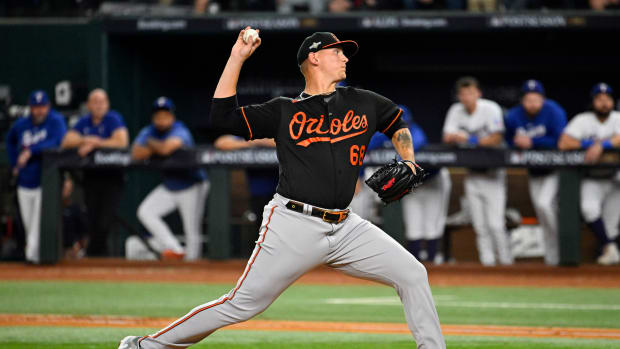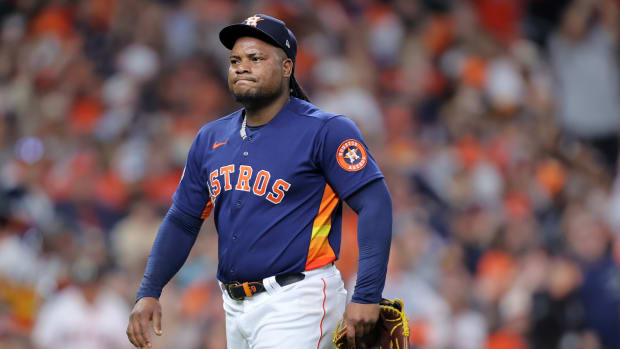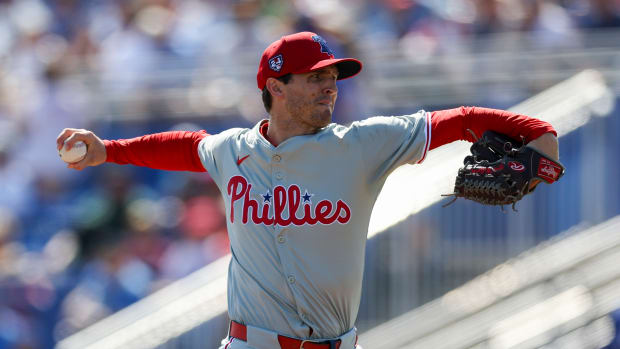NLDS Game 1 preview: Strasburg leads Nationals against Giants
Start Time: 3:07 p.m. ET
TV: FOX Sports 1
Starting Pitchers:Jake Peavy (7-13, 3.73 ERA) vs. Stephen Strasburg (14-11, 3.14 ERA)
This is the moment the Nationals have been waiting for: not only a chance to return to the postseason after their agonizing late-inning collapse in Game 5 of the 2012 Division Series against the Cardinals, but also a chance for the No. 1 pick of the 2009 draft to pitch in a postseason game.
• Complete postseason schedule, start times and TV listings
2014 playoff team preview: Washington Nationals
The 26-year-old Strasburg had an impressive season, making 34 starts, throwing 215 innings and tying Johnny Cueto for the NL lead in strikeouts (242, 10.3 per nine) with a stellar 5.93 strikeout-to-walk ratio. Some of the shine was taken off his numbers by a bit of randomness or bad luck via a high batting average on balls in play (.321) and rate of home runs per flyball (13.1 percent, up from a career 11.3 percent), the latter of which resulted in a career-worst 1.0 homers per nine. That said, Strasburg was much more effective in Nationals Park (2.56 ERA, 0.9 HR/9, 11.5% HR/FB, 7.8 K/BB) than elsewhere (3.82 ERA, 1.1 HR/9, 15.0% HR/FB, 4.0 K/BB). That's good news for the Nationals; with 96 wins, Washington earned home field advantage throughout the NL playoffs, and Strasburg is lined up to make two starts at home in this series.
Here's what BrooksBaseball.net has to say about Strasburg's arsenal:
In 2014, he has relied primarily on his Fourseam Fastball (96mph) and Change (89mph), also mixing in a Curve (81mph). He also rarely throws a Sinker using a Two-seam Fastball grip (95mph) and Slider (87mph).
...His fourseam fastball has well above average velo, results in somewhat more groundballs compared to other pitchers' fourseamers and has slight armside run. His change is thrown extremely hard, is a real worm killer that generates an extreme number of groundballs compared to other pitchers' changeups, generates a high number of swings & misses compared to other pitchers' changeups, has slight armside fade and has some natural sink to it. His curve generates more whiffs/swing compared to other pitchers' curves, has a sharp downward bite, is slightly harder than usual, results in somewhat more groundballs compared to other pitchers' curves and has slight glove-side movement. His sinker is basically never swung at and missed compared to other pitchers' sinkers, has well above average velo and has slight armside run. His slider generates an extremely high number of swings & misses compared to other pitchers' sliders, generates a very high amount of groundballs compared to other pitchers' sliders and is much harder than usual.
Thanks to a huge gap in BABIP (.353 versus righties, .283 versus lefties), Strasburg showed a slight reverse platoon split in 2014 (34 points of OPS), but for his career, he's been less effective against lefties by a gap of 51 points. In Brandon Belt, Gregor Blanco, Brandon Crawford, Joe Panik and switch-hitter Pablo Sandoval, the Giants have a heavy lefthanded presence — even heavier with manager Bruce Bochy putting Travis Ishikawa in leftfield again, as he did in the Wild-Card Game — though as a team they were less effective against righties (.253/.307/.387) than lefties (.258/.318/.390).
2014 playoff team preview: San Francisco Giants
The presence of Ishikawa, who was making just his fourth major league start in left, owes to the absences of Mike Morse and Angel Pagan due to injuries. Morse (.279/.336/.475 for a 130 OPS+) played just one game in September due to an oblique strain and has been left off the roster as a result. Pagan (.300/.342/.389 for a 110 OPS+) was limited to just 96 games this year due to a bulging disc that required season-ending surgery last week. When he was in the lineup, the Giants went 56-35; in all other games, they were 33-39. San Francisco will miss him on both offense and defense.
• ROSENBERG: Easy-going Bumgarner downs Pirates in NL Wild-Card Game
Taking the ball for the Giants is Peavy, who was awful for the Red Sox (4.72 ERA, 4.80 FIP, 1.5 HR/9 in 20 starts) and much better after being acquired in July (2.17 ERA, 3.03 FIP, 0.3 HR/9 in 12 starts) thanks in part to the more pitcher-friendly ballparks of the NL West. He joined the team at a time when Madison Bumgarner and Tim Hudson were San Francisco's only starters preventing runs at a better-than-average clip; it's quite likely the Giants wouldn't have made it this far without him. That said, Peavy's stuff isn't what it was in his Cy Young-winning heyday with the Padres. Here's what BrooksBaseball.net has to say about it:
In 2014, he has relied primarily on his Fourseam Fastball (91mph) and Cutter (87mph), also mixing in a Sinker (91mph), Change using a Circle Change grip (83mph), Curve (81mph) and Slider (82mph).
…His fourseam fastball has an obvious tail, results in somewhat more flyballs compared to other pitchers' fourseamers and has slightly below average velo. His cutter generates more whiffs/swing compared to other pitchers' cutters, results in many more groundballs compared to other pitchers' cutters and has little cutting action. His sinker is basically never swung at and missed compared to other pitchers' sinkers, has an obvious tail and results in somewhat more flyballs compared to other pitchers' sinkers. His change results in somewhat more groundballs compared to other pitchers' changeups, has slight armside fade and has some natural sink to it. His curve has very little depth, has primarily 12-6 movement and is slightly harder than usual. His slider has primarily 12-6 movement.
The road to a title — or not — for every Division Series team
Peavy has long had a substantial platoon split, though this year it was a bit less pronounced. Lefties hit .249/.318/.448 against him, with 16 homers but just a .266 BABIP; righties hit .265/.317/.402 against him with seven homers and a .318 BABIP. With Denard Span, Bryce Harper, Adam LaRoche and switch-hitting Asdrubal Cabrera in the lineup — the latter at second, with Anthony Rendon at third and Ryan Zimmerman on the bench — the Nats do have a significant lefthanded presence in their lineup, though like the Giants, they were slightly weaker against righties (.248/.318/.391) than lefties (.268/.329/.399).
When it comes to bullpens, these two teams finished with the league's second- and third-lowest in terms of ERA (Nats 3.00, Giants 3.01) despite changing closers midway through the season (Drew Storen over Rafael Soriano in Washington, Santiago Casilla over Sergio Romo in San Francisco). A closer look at the peripherals shows an edge to the Nationals' 'pen in terms of home run rate (0.5 per nine to 0.7) and strikeout rate (8.4 per nine to 7.2) such that the former's FIP was significantly better than the latter (a league-best 3.05 to 3.44). That margin grows even wider when you consider ballparks (82 to 100 in FIP-, the lower number being the better one). Curiously, though, both were a touch or two worse than league average (28 percent) when it came to allowing inherited runners to score.
Division Series predictions: SI's experts make their ALDS, NLDS picks
For Washington, Soriano's September struggles didn't keep him off the roster, as he made it over Ross Detwiler, who would have been the third lefty along with Jerry Blevins and Matt Thornton. Don't expect him to have a big role, however. Soriano has been seeing fewer high-leverage opportunities as his performance has declined, while Craig Stammen and Aaron Barrett have joined Tyler Clippard among Williams' reliable late-inning righties. Storen (1.12 ERA, 2.71 FIP) saved 11 games on the year, including 10 straight in September.
For the Giants, Casilla (1.70 ERA, 3.18 FIP) notched 19 saves overall and went 16-for-17 after gaining the regular closer's job in July. Romo (3.72 ERA, 3.94 FIP, 1.4 HR/9) has worked his way back into a high-leverage role, generally as the eighth-inning guy with Jean Machi as the seventh-inning guy and lefties Javier Lopez and Jeremy Affeldt around for matchup purposes.
Also in the bullpen: Tim Lincecum, who squeaked onto the roster despite a horrid season. The former Cy Young was tagged for a 6.10 ERA in six relief appearances after being bumped from the rotation in late August, though the eight runs he allowed came in multi-inning garbage-time stints — a pair of games decided by a total of 27 runs.


































